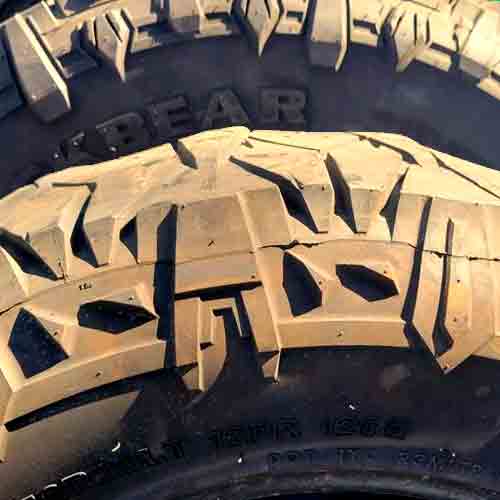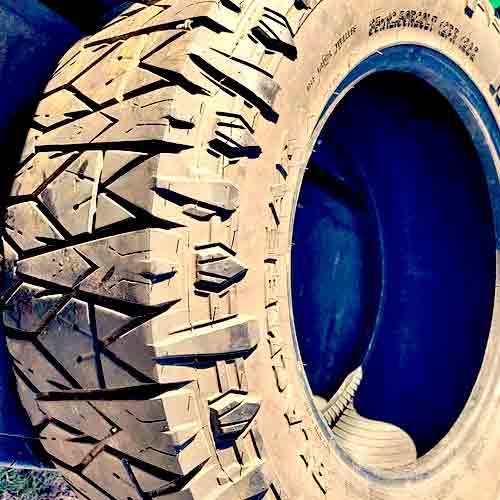If you’re looking for a tire that provides excellent performance off-road, with above-average highway grip, then Black Bear Rugged Terrain is a decent option, worth considering. The tire may not be as popular, but its packed with cutting-edge tread compounds and asymmetric tread pattern that meets your expectations.

In my expert opinion as a tire engineer, the Black Bear Rugged Terrain despite having such aggressive structure, features a decent grip on paved roads. Though that only goes when things are dry, as the tire could use a lot of help in wet conditions. Speaking of drawbacks, the tire also lacks in the area of snow traction, and impact comfort. Though its noise reduction capabilities are still great. Lastly, off-road it’s a beast, on all types of terrains.
Tire Sizes
The Black Bear Rugged Terrain comes in very limited 26 sizes in 15 to 22 inches rims. They have following specs.
- They are all rated with Q in speed ratings.
- Have load ratings, XL, C, D, E and F.
- Tread depth: 19 or 21/32″.
- They don’t offer tread wear warranty.
- Weight: 45 to 87 lbs.
Tread Appearance
Black Bear Rugged Terrain offers a very unique tread design.

It’s asymmetric structure is equipped with triangularly shaped lugs all over the tread.
And they form a combination of lateral tread voids at multiple angles.
All of it’s lugs, although have sharp edges to them, they are missing with other kinds of biters, and whole a lot of siping.
Though the tread voids they make act as in-groove notches off-road.
Furthermore, the tire’s sidewall lugs are very aggressive looking.
They form a combination of elongated and diamond shaped lugs throughout, joined up together with heat diffusers, underneath.
Snow Performance
For get optimal winter performance from an off-road tire, two key features are required: snow gripping abilities and effective paddling. Unfortunately, the Black Bear Rugged Terrain tire does not excel in either of these aspects.
The tire’s design incorporates a significant amount of rubber contact area, and only includes in-groove biters, resulting in insufficient snow-to-snow contact (with greater snow to rubber exposure).
Snowflakes basically like to stick with one another, and result in greater frictional forces compared to rubber’s contact. That’s why the Black Bear RT also is not branded with 3 peak mountain snowflake rating.
Highway Grip
Grip is primarily determined by the tread’s contact with the ground, and the Black Bear Rugged Terrain offers an impressive amount of contact, even though it comes in the “hybrid” category.
So why is that?
Well, for the most part, its lugs have minimal features, allowing for substantial footprint offering capability. With fewer notches, sipes or biters, the tire achieves a satisfactory stopping efficacy, as more of its rubber meets the road.
To give you a ball park, its directional grip surpasses that of the Nitto Ridge Grappler, which is a pretty performing rugged terrain tire on pavements.
The Black Bear’s futuristic looking blocks, having a mixture of trapezoids and triangles form a great combination of biting efficacy and contact patch, and it’s stiffer compound allow for superb steering feedback.
This further gets aided by its 3 ply sidewalls (adding to overall stiffness), and its asymmetric design.
Though it comes at a cost, as the tire shows a lot of slippage in wet conditions.
Wet Traction
Wet grip depends on sipes and grooves.
The grooves prevent water to get accumulated in the tread (channeling them out), while the sipes wipe off the remaining water (by sucking them in).
The Black Bear R/T although features good enough water leaving pathways, it highly lacks in siping.
So you get a very limited traction.
Fuel Usage
Fuel consumption is influenced by a tire’s weight and tread design, which can help explain the lower values of fuel economy observed for the Black Bear R/T.
While the tire doesn’t have an excessively soft tread compound, it does possess a substantial tread depth, measuring up to 21/32″.
This causes it’s tread lugs to bend and flex a lot more than needed, adding to overall energy expenditure (as that translates in to excessive heat and frictional forces).
That’s why despite having an a lot of rubber footprint offering (compared to other hybrids out there), the Black Bear R/T’s fuel efficiency is not very impressive.
Tread Life
The tread depth factor, which causes the Black Bear R/T to have a high rolling resistance, also accounts for a decent tread longevity.
Simply put more the tread depth, the longer a tire would take to reach down to the legal limit of 2/32″, and this tire has plenty, 21/32″ (which is even comparable to mud terrain tires, which are the most aggressive).
Furthermore, the tire also has another advantage as well, and that is it’s stiffer rubber composition, which is not that prone to burning off too fast, relatively.
Off-Road Traction
When it comes to off-road performance, there are a lot of variables to consider. Luckily, we can make things easier to grasp by dividing them in the following terrain types.
Sand/Desert
While tire air pressure plays a vital role in sand performance by facilitating better flotation, specific tread features can further enhance that further. And all these factors are accessible with the Black Bear R/T.
The tire exhibits improved grip on various sandy surfaces, including deep dunes, thanks to it’s decent contact patch offering, and thick section width.
And besides providing more rubber area to meet with the road, you also get nice sidewall lugs which expand out, resulting in further improvement of the tire’s footprint and hence sand traction.
On Mud
Effective mud handling demands tires with wider grooves and self-cleaning properties, which basically facilitate quick mud evacuation, enhancing traction and stability.
Having said that the Black Bear R/T excels in all types of muddy conditions due to its network of grooves connecting each part (shoulders) of the tread, which allows mud to exit at various angles unimpeded.
Additionally, the tire features thick diamond-shaped sidewall lugs, which contribute to overall traction by providing efficient paddling, throwing thick debris backwards, and generating forward moving inertia with it.
Rocks
For rocky terrains, the Black Bear R/T offers dependable performance, attributed to its robust 3-ply sidewall construction and thick, sturdy lugs on both sides and in the middle (with it’s asymmetric pattern).
These lugs, combined with laterally-oriented tread voids, provide excellent climbing abilities, where the multi-angled-lug design account for fabulous gripping on all types of rocky surfaces, and in all directions.
Although the tire is missing with intricate biters, and has a stiffer tread compound, it’s lugs are still able to bite in, especially when you lower the air pressure. Though it results in better sand traction.
Conclusion
The Black Bear R/T is a hybrid tire that strikes a balance between off-road traction and durability, while potentially offering better fuel efficiency and tread life compared to traditional Mud terrain tires.
It performs well in deeper snow and rocky terrains but may struggle in mud and sand compared to more specialized options.
Overall, the Black Bear R/T could be a suitable choice for those seeking a rugged terrain tire that combines off-road capabilities with some on-road advantages.